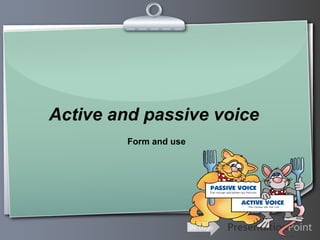
Active and-passive-voice
- 1. Active and passive voice Form and use Ihr Logo
- 2. A sad story… Last week I found a great apartment. The rent was reasonable. That’s why… Page 2 Your Logo
- 3. I decided to throw a party the other night. Page 3 Your Logo
- 4. The next day I was thrown out of it! Page 4 Your Logo
- 5. Active or passive I threw a party the other night. (active) meaning: I did something. I was thrown out of it. (passive) meaning: Something was done to me. Page 5 Your Logo
- 6. Form The passive is formed with the verb to be (in the appropriate tense) + past participle (of the main verb) The terrorist was arrested early this morning. Toyota cars are made in Japan. A new class representative will be chosen on Monday. NB These examples show that a passive sentence can be in whatever tense you like. The tense of the verb to be changes to give different tenses in the passive. Page 6 Your Logo
- 7. Let’s review the verb to be The Present Simple Tense – AM, IS, ARE The Present Continuous Tense – AM/IS/ARE BEING The Present Perfect Tense – HAVE BEEN, HAS BEEN The Past Simple Tense – WAS, WERE The Past Continuous Tense – WAS/WERE BEING The Past Perfect Tense – HAD BEEN The Future Tense – WILL BE With modals – CAN BE, WOULD BE, SHOULD BE, MAY BE, MUST BE… Page 7 Your Logo
- 8. Do these sentences have the same meaning? What’s the difference? Page 8 Your Logo
- 9. Use The passive is more common in written than spoken English. It sounds formal and impersonal, and for that reason is often used in: reports of crimes or legal procedures – He was sentenced to two years in prison. newspaper reports – The match was postponed due to a heavy fog. scientific writing – Three millilitres of water are added to the mixture. announcements – Flight BA 302 to London is delayed by two hours. notices – Customers are requested not to smoke. Page 9 Your Logo
- 10. Use In everyday situations we use it when we do not know or care who performs the action. In other words, the passive is used when we are more interested in what happens to a thing or a person. Nevertheless, it is not unusual to mention the ‘actual doer’ in a passive sentence. In that case we put them at the end of the sentence after the preposition by: “Great expectations” was written by Charles Dickens. “Star wars” was directed by George Lucas. Page 10 Your Logo
- 11. Practice Put the verbs in brackets into the correct passive form Shampoo __________ (test) on animals before it ___________ (sell) in shops. This house __________ (build) in the XIX century. Two missing children _____________ (find) safe and well. A new bridge ____________ (construct) next year. Page 11 Your Logo
- 12. Practice – the key Put the verbs in brackets into the correct passive form Shampoo is tested (test) on animals before it is sold (sell) in shops. This house was built (build) in the XIX century. Two missing children have been found (find) safe and well. A new bridge will be constructed (construct) next year. Page 12 Your Logo
- 13. Active → Passive (steps) Example: (active) The postman delivers the letters at 09.00. Step 1 – identify the object of the active sentence and place it at the beginning of the passive sentence. (the letters) Step 2 – identify the tense of the active verb and put the verb to be into the same tense. (are) Step 3 – turn the main active verb into the past participle form. (delivered) (passive) The letters are delivered at 09.00. Page 13 Your Logo
- 14. Practice - Active Passive The police arrested the suspect late last night. ____________________________________ They found him after an intensive search. ____________________________________________________ Two detectives questioned him and charged him with murder. ________________________________________ They will take him to court later today. _________________________________ Page 14 Your Logo
- 15. Active Passive (the key) The police arrested the suspect late last night. The suspect was arrested late last night. They found him after an intensive search. He was found after an intensive search. Two detectives questioned him and charged him with murder. He was questioned and charged with murder by two detectives. They will take him to court later today. He will be taken to court later today. Page 15 Your Logo
- 16. Summary In an active sentence the subject always precedes the action (verb). S+P+O In a passive sentence the object becomes the subject i.e. the one that is acted upon. The predicate (verb) consists of the verb to be and the past participle of the main verb. If necessary, you can use ‘by’ to say who or what is responsible for the action. It is often used when we do not know or care who performs the action. Page 16 Your Logo
- 17. Thanks for attention! Page 17 Your Logo